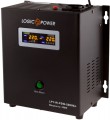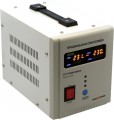Form factor
—
Standard (Tower). UPS designed for floor mounting or placement on any suitable horizontal surface. This “installation” is extremely simple, and it is suitable even for the most powerful and heaviest devices, and therefore most modern uninterruptible power supplies (of all categories) are made in the usual Tower form factor. They are supposed to be placed vertically.
—
Rack. Models for installation in telecommunication racks. Most of these uninterruptible power supplies belong to the professional equipment segment, designed to power servers and other similar electronics (which are also often mounted in a similar way). The most common standard of racks is 19", however there are other options, so it would not hurt to check the compatibility of the UPS with a specific rack separately. We also note that models of this type are often equipped with legs that allow you to place the device on the floor “sideways” or in a vertical position. Display (if available) in such models may have a rotating design for ease of reading parameters in both positions.
—
Wall-mounted. Uninterruptible power supplies, primarily designed for wall mounting. Wall hanging may be the best option in tight spaces. However, such an installation is not the only option - many devices can optionally be installed on the floor. Also note that wall-mounted UPSs are often used for heating boile
...rs. The main disadvantage of this form factor is the need to drill into the walls to install an uninterruptible power supply.
- Flat. UPS, structurally assembled in a low, flat housing. As a rule, this form factor allows for several options for installing equipment: the uninterruptible power supply can be installed horizontally or vertically. However, it is the horizontal method of installing the UPS that predominates. In fact, everything depends on the location of the uninterruptible power supply and its dimensions - it would not hurt to clarify this point separately.
— Extension cord. Uninterruptible power supplies that resemble an extension cord in appearance. Structurally, such UPSs consist of a set of sockets in one housing, with the sockets located on the top platform of the uninterruptible power supply. Often, the housing of such UPSs is provided with holes or fasteners for wall mounting.Switching to battery
The time required to transfer the load from mains power to battery power. In standby and
interactive UPSs (see Type), a short-term power failure occurs at this moment — accordingly, the shorter the time to switch to the battery, the more uniform the power supply is provided by the source during a power failure. Ideally, the switching time for the traditional 50 Hz AC frequency should be less than 5 ms (a quarter of one cycle of the sine wave). With inverter UPSs, the transfer time is, by definition, zero.
Input voltage range
In this case, the input voltage range is implied, in which the UPS is able to supply a stable voltage to the load only due to its own regulators, without switching to the battery. For redundant UPSs (see "Type") this range is quite small, approximately 190 to 260 V; for interactive and especially inverter ones, it is much wider. Some UPS models allow you to manually set the input voltage range.
Max. current
The maximum current drawn by the UPS. In fact, the current reaches its maximum value only when the UPS is operating from the mains with maximum load power and a completely discharged battery. However, when calculating the load on the power grid, this parameter should be taken into account.
Bypass (direct connection)
Bypass(by-pass) means such a mode of operation of the UPS, in which power is supplied to the load directly from an external source — the mains, diesel generator, etc. — practically without processing in the UPS itself. This mode can be activated either automatically or manually.
— The automatic bypass is a kind of safety measure. It turns on when the UPS in normal mode cannot supply power to the load — for example, when the UPS is overloaded due to a sharp increase in the power consumption of the load.
— Manual bypass allows you to enable this mode at the request of the user, regardless of the operating parameters. This may be necessary, for example, to hot-swap a battery (see below for details) or to start equipment that has a starting capacity greater than that of the UPS. Technically, it can also play the role of a security measure, but automatic systems are more reliable in this sense.
Some UPSs provide both options for enabling the bypass.
Output voltage accuracy
This parameter characterizes the degree of difference between the AC voltage at the output of the UPS and the perfect voltage, the graph of which has the shape of a regular sinusoid. The perfect voltage is so named because it is the most uniform and creates the least unnecessary load on the connected devices. Thus, the distortion of the output voltage is one of the most important parameters that determine the quality of the power received by the load. A distortion level of 0% means that the UPS produces a perfect sine wave, up to 5% — slight sine wave distortion, up to 18% — strong distortion, from 18% to 40% — a trapezoidal signal, more than 40% — a square wave.
Output frequency
The frequency (frequency range) of the AC voltage output by the UPS. For computer technology, the frequency range of 47-53 Hz is considered normal, although the smaller the deviation from the 50 Hz standard, the better. On the other hand, in some UPS models, this frequency can be automatically synchronized with the frequency of the mains — so the power supplied to the load will not differ regardless of whether the load is powered by the mains or from the battery. In this case, a wider frequency range, on the contrary, is more desirable.
Redundant sockets
The number of
outlets connected to the power reserve(battery) provided in the design of the UPS. In order for the UPS to fulfill its main role (providing a backup power in case of power outages), the corresponding electrical appliances must be connected to these outlets. The sockets have a standard shape and are compatible with the vast majority of popular 230 V plugs.
At a minimum, the UPS has
1 or
2 outlets and, in more advanced ones, there may be
3 or
more.
Protection
The protection functions provided in the design of the UPS.
—
Short circuit protection. A short circuit is a sharp drop in load resistance to critically low values, due to which the current strength increases and the UPS experiences significant overloads that can disable the device and even cause a fire. It may be caused by a problem with the connected device, poor insulation, foreign objects, etc. In the event of such a situation, the short circuit protection system turns off the UPS, preventing unpleasant consequences.
—
Overload protection. Overload in this case is the excess of the load power consumption over the output power of the UPS. Working in this mode can also lead to unpleasant consequences up to breakage and fire; to avoid this, a protection system is installed that turns off the UPS when an overload occurs.
—
Overcharging protection of external battery. The overcharge protection function prevents the accumulation of excess energy in the battery, from which the UPS operates in autonomous mode. Overcharging is highly undesirable for any type of battery. It can lead to various unpleasant consequences - from deterioration in performance to overheating and fire of the battery. The automatic protective equipment on board the uninterruptible power supply turns off the power after the battery is fully charged. This prevents “extra” curre
...nt from entering the battery, which could damage it. This system is convenient in that the battery can be left on charge for a long time without fear of overexerting it.
— Noise filtering. A system that suppresses high-frequency interference in an electrical network — these can be either single voltage surges when turning on and off powerful electrical appliances, or long-term interference from constant sources, such as electric motors. These interferences can adversely affect the operation of electronics connected to the network (up to visible failures); the noise filtering system avoids this. Such systems are quite simple, and therefore most modern UPSs are equipped with them.
— Data line protection. High-frequency interference protection system, similar to interference filtering (see above) — only used not in an electrical network, but in a telephone or wired computer (LAN) network. Such networks are also subject to interference from various sources of electromagnetic radiation, which can cause failures of equipment connected to them: PCs, printers, fax machines, etc. UPSs with this feature have at least two LAN standard connectors (input and output), into which appropriate network or telephone (with RJ-11 connectors compatible with LAN) cables are inserted.
— Emergency cut-off. This connector allows you to connect the UPS to an emergency power off system. Thus, in an emergency (for example, in the event of a fire), the entire room, including and with a power reserve, can be completely de-energized by pressing one button. Without this, the UPS would simply switch to battery when the power goes out and leave the equipment energized, which could lead to disastrous consequences.
— Sound alarm. A system that gives an audible signal in various important situations. It is most commonly used to signal a power outage and the UPS is transferring to battery power. Without a sound signal, this could not be noticed at all (the light is not always on in the room, it goes out when the network fails, the contact in the socket itself may disappear, etc.), which is fraught with a sudden shutdown of the equipment, data loss and breakdowns. Also, sound alarm can be used for other events — low battery, end of charge, bypass on / off, etc.
